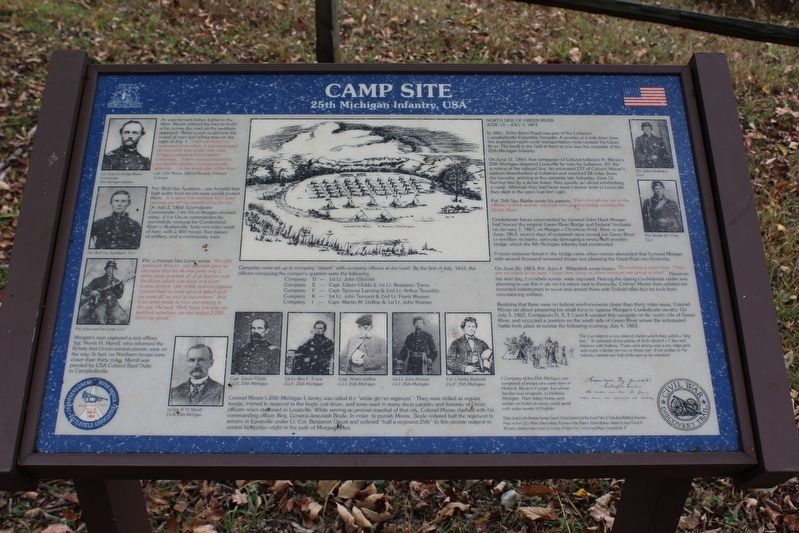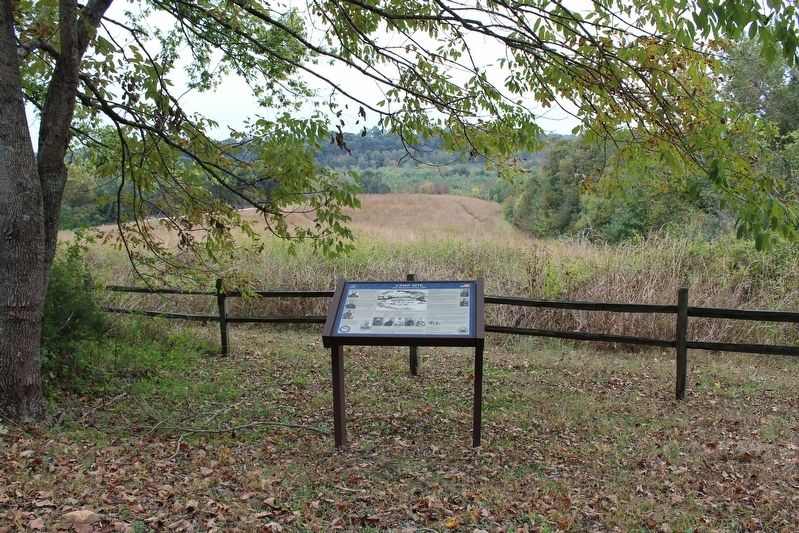Near Campbellsville in Taylor County, Kentucky — The American South (East South Central)
Camp Site
25th Michigan Infantry, USA
Pvt. Wulf Van Apeldoon was hopeful that high water from recent rains would protect them: "It is good that we have high water because the rebels cannot come across. On July 2, 1863, Confederate Commander John Hunt Morgan shocked many of the Union commanders by successfully crossing the Cumberland River at Burkesville, forty-two miles south of here, with 2,460 troops, four pieces of artillery, and a commissary train.
Pvt. Johannes Van Lente wrote: "At night around 8:30 p.m., our adjutant gave us the news that the Rebels were only 2 miles away and that all of us had to cross the River, which was done in a short course of time. Our noble and courageous Colonel had us lined up and asked us if we were all 'as cool as cucumbers.' And if we were ready to look our enemy in the eye. He said, 'Well, boys, the way we fortified ourselves, we can defeat 2,000...Don't be afraid.'"
Morgan's men captured a sick officer, Sgt. Norris H. Merrill, who informed the Rebels that Union reinforcements were on the way. In fact, no Northern troops were closer than thirty miles. Merrill was paroled by CSA Colonel Basil Duke in Campbellsville.
Campsites were set up in company "streets" with company officers at the head. By the first of July, 1863, the officers occupying the company quarters were the following:
Company D - 1st Lt. John Gilchrist
Company E - Capt. Edwin Childs & 1st Lt. Benjamin Travis
Company F - Capt. Spencer Lansing & 2nd Lt. Arthur Twombly
Company K - 1st Lt. John Tennany & 2nd Lt. Frank Weaver
Company I - Capt. Martin M. DeBoe & 1st Lt. John Kramer
Colonel Moore's 25th Michigan Infantry was called the "white glove regiment." They were drilled as regular troops, trained to respond to the bugle and drum, and were used in many dress parades and funerals of Union officers when stationed in Louisville. While serving as provost marshal of that city, Colonel Moore clashed with his commanding officer, Brig. General Jeremiah Boyle. In order to punish Moore, Boyle ordered half the regiment to remain in Louisville under Lt. Col. Benjamin Orcutt and ordered "half a regiment 25th" to this remote outpost in central Kentucky—right in the path of Morgan's Men.
North Side of Green River June 13 - July 3, 1863
In 1863, Tebbs Bend Road was part of the Lebanon-Campbellsville-Columbia Turnpike. A quarter of a mile from here, this important north-south transportation route crossed the Green River. The knoll in the field in front of you was the campsite of the 25th Michigan Infantry.
On June 11, 1863, five companies of Colonel Orlando H. Moore's 25th Michigan departed Louisville by train for Lebanon, KY, the terminus of the railroad line. An estimated 237 of Colonel Moore's soldiers disembarked at Lebanon and marched 28 miles down the turnpike, arriving at this campsite late Saturday, June 13. Surrounded by a dense forest, they quickly set about establishing a camp. Although they had been issued shelter tents in Louisville, they slept in the open that first night.
Pvt. Dirk van Raalte wrote his parents: "Even though we are in the middle of thick woods, our duty is to guard a bridge crossing the Green River."
Confederate forces commanded by General John Hunt Morgan had burned the original Green River Bridge and Federal Stockade on January 1, 1863, on Morgan's Christmas Raid. Now, in late June, 1863, several days of sustained rains caused the Green River to overflow its banks, seriously damaging a newly-built wooden bridge, which the 9th Michigan infantry had constructed.
A more ominous threat to the bridge came when rumors abounded that General Morgan with several thousand seasoned troops was planning the Great Raid into Kentucky.
On June 26, 1863, Pvt. John A. Wilterdink wrote home: "Everything is quiet here. There are no rebels to be seen. I hope they leave us alone because our group is small." However, the next day, two rebel scouts were captured. Fearing the daring Confederate raider was planning to use this route on his return raid to Kentucky, Colonel Moore then enlisted ten mounted infantrymen to scout and armed them with Enfield rifles that he took from convalescing soldiers.
Realizing that there were no federal reinforcements closer than thirty miles away, Colonel Moore set about preparing his small force to oppose Morgan's Confederate cavalry. On July 3, 1863, Companies D, E, F, I and K vacated this campsite on the north side of Green River, and occupied a position on the south side of Green River where the anticipated battle took place at sunrise the following morning, July 4, 1863.
(captions)
The men slept in a new kind of shelter which they called a "dog tent." It consisted of two pieces of cloth about 4x7 feet and fastened with buttons. These were strung over a low ridge pole and made a shelter for two or three men. Each soldier in the infantry carried one half of the tent as he marched.
I Company of the 25th Michigan was composed of troops who were born in Holland, Western Europe, but whose families had emigrated to Holland, Michigan. Their letters home were written in Dutch as many could speak only a few words of English.
Erected by Kentucky Heartland Civil War Trails Commission.
Topics and series. This historical marker is listed in this topic list: War, US Civil. In addition, it is included in the John Hunt Morgan Heritage Trail in Kentucky series list. A significant historical year for this entry is 1863.
Location. 37° 15.025′ N, 85° 21.64′ W. Marker is near Campbellsville, Kentucky, in Taylor County. Marker is on Tebbs Bend Road, 0.2 miles west of New Columbia Road (Kentucky Route 55), on the right when traveling south. Touch for map. Marker is in this post office area: Campbellsville KY 42718, United States of America. Touch for directions.
Other nearby markers. At least 8 other markers are within 2 miles of this marker, measured as the crow flies. Federal Hospital (about 700 feet away, measured in a direct line); Civil War Camp Hobson (approx. 0.3 miles away); Green River Bridge / Green River Bridge Skirmish Site (approx. 0.3 miles away); Federal Stockade (approx. half a mile away); Federal Field Hospital (approx. 0.6 miles away); Battle of Green River Bridge (approx. 0.9 miles away); "No Day to Surrender" (approx. 0.9 miles away); Morgan's Demand for Surrender (approx. 1.1 miles away). Touch for a list and map of all markers in Campbellsville.
Also see . . .
1. 25th Michigan Infantry in the American Civil War. (Submitted on October 29, 2016, by Tom Bosse of Jefferson City, Tennessee.)
2. Tebbs Bend-Green River Bridge Battlefield Association. (Submitted on October 30, 2016.)
Credits. This page was last revised on May 17, 2019. It was originally submitted on October 29, 2016, by Tom Bosse of Jefferson City, Tennessee. This page has been viewed 515 times since then and 10 times this year. Last updated on May 17, 2019, by Bradley Owen of Morgantown, West Virginia. Photos: 1, 2. submitted on October 29, 2016, by Tom Bosse of Jefferson City, Tennessee. • Andrew Ruppenstein was the editor who published this page.

